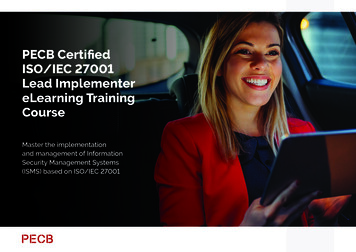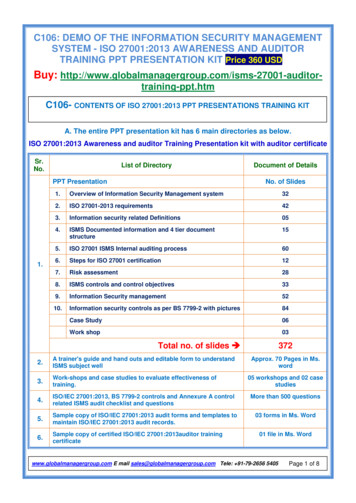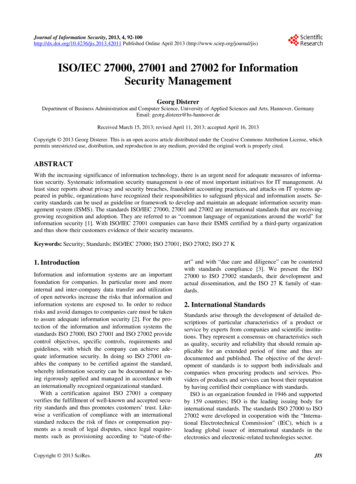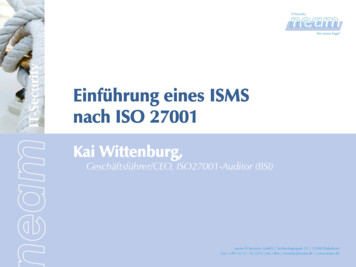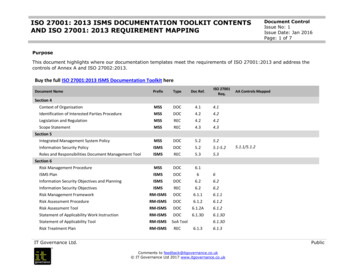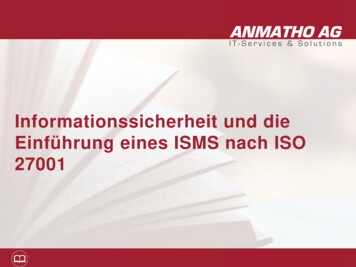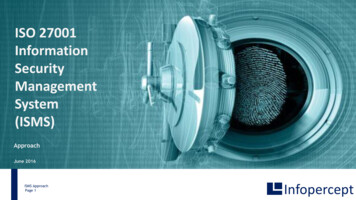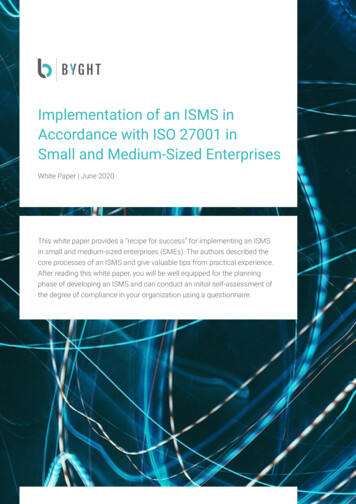
Transcription
Implementation of an ISMS inAccordance with ISO 27001 inSmall and Medium-Sized EnterprisesWhite Paper June 2020This white paper provides a “recipe for success” for implementing an ISMSin small and medium-sized enterprises (SMEs). The authors described thecore processes of an ISMS and give valuable tips from practical experience.After reading this white paper, you will be well equipped for the planningphase of developing an ISMS and can conduct an initial self-assessment ofthe degree of compliance in your organization using a questionnaire.
White Paper Implementation of an ISMS in Accordance with ISO 27001June 2020CONTENTSIntroduction3Contents and structure of ISO 27001 Chapters 4–10 Annex A46Recipe for success Documentation/organization Risk management Internal auditing Information security incidents Awareness ISMS self-assessment Reporting Continual improvement process (CIP)79111213141516Summary172
White Paper Implementation of an ISMS in Accordance with ISO 27001June 2020IntroductionA GOOD ISMS IS,ABOVE ALL, EFFECTIVEEstablishing a certification-ready ISMS requires, among otherthings, creating many new documents. Cultivating anawareness for security and establishing new processes withinthe company are also unavoidable. This can be especiallychallenging for SMEs, where resources are often in short supply.The market for security experts who can take on the afore-is very clear: There is no such thing as 100% security. Abovementioned tasks within the company is not overwhelminglyall, opportunities for improvement should be identified andlarge – to put it positively. Costly external consulting servicesimplemented in a structured way when operating an ISMS.and complex, expensive ISMS tools seem unavoidable. InIf this drive can be demonstrated to the auditor during thethis white paper, we would like to demonstrate an alterna-audit, a lot has already been achieved.tive approach and provide SMEs with a “guiding light” to helpthem establish aAs much as necessary, but as little as possiblesuitable ISMS. OurIt is important to startmotto here is: “AsIn addition to ISO 27001 certification, the constantly increas-and not put off themuch as neces-ing number of threats is another good argument in favor ofsary, but as littleinvesting more time and consideration in the security struc-seemingly insurmountableas possible.” Thatture of the company. When damages to the company, suchchallenge that isdoes not meanas loss of image, data losses, and interruptions in businesssacrificing an ap-operations, can be reduced by implementing appropriatepropriate level oftechnical and organizational security measures, not only issecurity. On thethe auditor happy but management is happy as well. There-otheranfore, a good ISMS is, first and foremost, effective, and onlyISO 27001 certification.hand,ISMS should notthen should we concern ourselves with meeting all the re-get in the way of the core business, it should help shape thequirements laid out in the standard. A good auditor will seebusiness to be as secure as possible.that and include it in their evaluation. Again, everything canstill be improved – and this improvement can continue untilIn principle, we rely on collaborative and agile methods whenthe surveillance audit the next year.developing and operating an ISMS. Fewer complex tools,fewer individual makeshift solutions in huge Excel spread-There are, however, naturally some “hard facts” that are re-sheets. It is important to start and not put off the seeminglyquired in order to pass an ISO 27001 ISMS audit. The abso-insurmountable challenge that is ISO 27001 certification.lutely necessary and effective facts are presented and described in the following.In the end, it is about continual improvement and not aboutachieving 100% at the certification audit. Because one thing3
White Paper Implementation of an ISMS in Accordance with ISO 27001June 2020Contents and structure of ISO 27001CHAPTERS 4–10ISO 27001:2013 is an international standard describingthe requirements for setting up, implementing, maintaining,and continually improving an ISMS.The standard is divided into two sections: the obligatory management framework and Annex A. In contrast to the controls (measures) in Annex A of the stan-NOTE: Don’t let the yearsdard, which can be deselected with justified reasoning as part of the Statementlisted in the version numbersof Applicability (see below), implementing the requirements from Chapters 4–10of the standard confuse you.is mandatory. Using the following table, you can conduct an initial self-assess-Sometimes ISO 27001:2015ment of the degree of compliance in your organization.or ISO 27001:2017 is also mentioned. In this case, referenceChapters 4–10is being made only to theGerman translations. RegardlessChapters 1–3 of the standard cover basic topics which do not require implemen-of which number is stated, thetation. Sections 4–10 must be implemented.basis for the certification is stillthe English version from 2013.Chapter4.Questions1. Have stakeholders been identified and their (potential) effect on the ISMSdocumented?Context of theorganization2. Has the scope of the ISMS been defined?3. Have the legal requirements in the context of the ISMS been identified?1. Is management fulfilling its obligations by, among other things: E stablishing an information security strategy, Integrating the ISMS into business processes, Providing the necessary resources, M easuring the effectiveness and continual improvement of the ISMS, and Raising awareness among employees at all levels?5.2. Has management adopted an information security policy and made it known?3. Has management assigned roles, responsibilities, and authorizations withinthe ISMS and is management receiving the appropriate reports from theseLeadershippeople?4
White Paper Implementation of an ISMS in Accordance with ISO 27001ChapterJune 2020Questions1. Have measures for handling the identified risks and opportunities beenestablished?2. Has a process for identifying, assessing, and treating information security6.risks been established?3. Is a Statement of Applicability for Annex A documented?4. Have the objectives of the ISMS been determined and has a plan to achievePlanningthem been established?1. Have the necessary resources for the ISMS been provided?2. Do the relevant people have the required competencies to carry out theirroles within the ISMS?3. Has awareness been raised among all employees regarding The ISMS policy, Their duty to cooperate within the ISMS, and7. The consequences of non-compliance with ISMS requirements?4. Has internal and external communication been determined within the ISMS?5. Is the information and evidence required by the standard for measuring theSupporteffectiveness of the ISMS documented and managed?1. For planning and control, the organization must establish and document aseries of processes. For this purpose, one process counts toward each of thefollowing: Meeting the information security requirements, Controlling measures, Controlling tasks that have been outsourced to service providers, and8. Considering information security in planned changes.2. Is a risk assessment performed regularly and in the event of significantupdates?Operation3. Is risk treatment performed?1. Is there a process for monitoring the effectiveness of the ISMS?9.2. Are regular internal audits performed?3. Is there an audit program?Reviewing theperformance4. Is a management review performed regularly that takes into account at leastthe points contained in Chapter 9.3 of the standard?1. Is non-conformity with the requirements of the ISMS responded to with10.adequate measures?2. Are the established measures assessed with regard to their necessity,introduced if necessary, and checked for effectiveness?Improvement3. Is continual improvement ensured within the ISMS?5
White Paper Implementation of an ISMS in Accordance with ISO 27001June 2020Contents and structure of ISO 27001ANNEX AIn addition to these ten chapters, ISO/IEC 27001:2013 also includesAnnex A, which contains 114 specific measures. These are dividedinto the following 14 categories:ChapterNumber of measuresA.5Information security policies2A.6Organization of information security7A.7Human resource security6A.8Asset management10A.9Access control14A.10Cryptography2A.11Physical and environmental security15A.12Operations security14A.13Communications security7A.14System acquisition, development and maintenance13A.15Supplier relationships5A.16Information security incident management7A.17Information security aspects of business continuity management4A.18Compliance86
White Paper Implementation of an ISMS in Accordance with ISO 27001June 2020Recipe for successDOCUMENTATIONAND ORGANIZATIONFor an ISO 27001-certified ISMS, “documentation” means inparticular creating information security policies. There are severalmandatory policies that must be presented during an audit.However, the standard does not contain information on thepolicy but cannot be complied with in practice. It is importantextent of these policies. On the contrary, the standard explic-to find a balance and to regularly review such documentsitly states that the extent of the documented informationand improve them if necessary.can differ from organization to organization. Decisive factorshere are, in particular, the size of the company and the typeScope and Statement of Applicabilityof products and services. The person responsible for information security at an SME should always keep that in mindIn addition to policies, there are many other documents spe-when it comes time to write the policies. Rather than focus-cific to the standard that must be presented during an audit.ing on extensive documents, it is more important that the re-This includes, first of all, the scope and what is known asquirements laid out in the policies are actually implementedthe Statement of Applicability (SoA). Together they are thewithin the company as a key part of the company culture.initial point of reference for the auditor, enabling them toThis is one aspect that can be checked easily during an au-form an image of the scope and the circumstances of thedit and is therefore often checked for exactly this reason. AISMS and of the company.negative example is excessive security requirements for theThe Statement of Applicability is a document outlining allcompany's own software development that are defined in a114 controls fromAnnex A of ISO27001. The State-MANDATORY POLICIES Information Security Policy Policy for risk management Policy for security incident management Policy for suppliers, service providers andcontractors Policy for the classification and management of information Policy for secure IT operations Policy for human resources and accessrights management General information security rules for allThe requirements mustment of Applica-be implemented within thebility serves to ver-company as a key part ofify and documentwhichcontrolsthe company culture.are applied and tojustify their selection. As an alternative, controls can also bedeselected with justified reasoning if the requirements arenot applicable to the scope of the ISMS. As an example, organizations can deselect the control “A.14.2.1 Secure development policy” if they do not develop software themselves.In practice, however, all the controls are often applied, and itis only sensible or possible to deselect controls in individualcases.employees7
White Paper Implementation of an ISMS in Accordance with ISO 27001June 2020Excerpt from a Statement of ApplicabilityIn order to understand which of the 114 controls apply, it isquirements of the ISMS. This can include, for example, theimportant to think about the scope in advance. The scope,company’s employees, management, lawmakers, superviso-often referred to as the field of applicability, describes in writ-ry authorities, and service providers. All of these stakehold-ing the limits and applicability of the ISMS. It is typical in larg-ers and their requirements must be recorded in a separateer organizations to only certify individual business areas in-document. For the sake of simplicity, this document can bestead of the entire organization. But it is possible to excludea simple table. As with all the documents, the informationindividual areas in smaller companies as well. For example, ifmust be checked regularly to ensure it is up to date and up-an international site that only conducts sales activities is notdated if necessary.covered by the ISMS, that must be described in the scope.Another aspect that is worth considering is the informationsecurity objectives. The company strategy established bymanagement serves as the basis for shaping and establishEXAMPLES OF INFORMATION SECURITYing the information security objectives. Especially at the be-OBJECTIVESginning of the ISMS implementation phase, it is recommend- S ensitizing all employees to the topic of informationsecurity E nsuring data center access security A vailability of 99.9% of data connections E arly detection of security incidents Continual increase in the maturity of the ISMS F ulfilling customers’ confidentiality requirementsfor their data C omplete documentation of operating proceduresto ensure availability R eliable support of business processes throughinformation technology E nsuring the continuity of operations within theorganization C ontinual identification, assessment, and treatment ofrisks to information securityed to define a few information security objectives that makeThe description of the scope is therefore also of interest tothe company’s own customers and other management system stakeholders, since it enables them to understand whichareas and topics are covered by the ISMS and which are not.In addition to the company’s own customers, there are ad-sense for the organization in question. These should strike abalance between implementation effort and usefulness. Theestablished information security objectives should also beas easy to measure as possible.In addition to the documents described, additional documents are also required for an audit. The following information box provides an overview of these documents.MANDATORY ISMS DOCUMENTS Scope (also known as field of applicability) Statement of Applicability (SoA) Stakeholders and their requirements I nformation security objectives Planning of ISMS resources ISMS rolls and responsibilities L egal and regulatory requirements I nternal and external communication within the ISMS Audit program Management report Risk treatment planditional stakeholders who have certain expectations and re-8
White Paper Implementation of an ISMS in Accordance with ISO 27001June 2020Recipe for successRISK MANAGEMENTThe risk management requirements pursuant to ISO 27001are described in the management framework of the standard.‘In principle, creating a process for identifying and assessinginformation security risks is required in order to “prioritize theanalyzed risks for risk treatment.”Of course, when repeated it must also lead to “consistent, applicable, and comparable results.” To do so, it is important for the first step to be establishing a policy which lays out the company’s risk management procedure. The policy shouldcontain at least the following points.CONTENTS OF THE POLICYFOR RISK MANAGEMENT1. Risk identification2. Risk assessmentIdentify – assess – treat3. Risk treatmentISO 27001 otherwise contains little about risk analysis methods, which provides4. Reportinga lot of freedom in implementation – but at the same time very little support.Help can be provided by the supplementary ISO 27005 or the method providedby the German Federal Office for Information Security (BSI) in its BSI IT-Grundschutz. For SMEs, a combination of these two methods can be a good option.This allows companies to benefit from the flexibility of the ISO standards and thetemplates and supporting information from the BSI. A process that is as lean aspossible but still leads to “consistent, applicable, and comparable results” couldlook something like this:Risk management processIdentify risksFirst, think about which information,business processes, or IT systemsare especially critical for yourbusiness operations. Then, ask yourinternal experts and also use threatcatalogs, like the one from the BSI,to identify relevant risks.Assess risksThe second step involves evaluatingthe identified risks. To do so, estimatethe impact and probability for eachrisk.Treat risksA treatment strategy should beestablished and documented for therisks with the highest value.The risk value results from theprobability and impact and can bedetermined in what is known as arisk matrix.9
White Paper Implementation of an ISMS in Accordance with ISO 27001June 2020Probability and impactIt is important to give thought in advance to an assessmentmodel for risks. This is the only way to ensure comparableresults and to prioritize the identified risks for risk treatment.The ISO 27001 standard does actually have rough guidelinesfor estimating the consequences of a risk occurring (impact)and the probability that the identified risks will occur. Thestandard does not go into more detail at this point.Classic possibilities for handling a risk are: Risk avoidance (discontinuation or adaptationof an activity) Risk reduction (identification ofsecurity measures) Risk transfer (i.e. insurance) Risk acceptance (management bearsthe risks)A four-tier model for assessing the two influencing factorsFor each of the high and very high risks, one of the afore-of impact and probability is common and also recommend-mentioned treatment options should be established in a risked by the BSI (see the following information box). In order totreatment plan.achieve comparability of the risks, they can be classified in arisk matrix. The risk value identified by this matrix indicatesThe results of risk management and the treatment planwhich risks should be prioritized for treatment.should be part of the yearly ISMS reporting to management.A risk-based approach to treatment means tackling thegreatest risks first. A sensible strategy would be to concentrate on the “high” and “very high” risks and consider the restas accepted.Risk : According to present estimates,event could occur at most once every MediumHighVery ighVery highMedium: Event occurs once every fiveyears to once a year.Very highFrequent: Event occurs once a year toonce a month.RareMediumFrequentVery frequentVery frequent: Event occurs several timesa month.Impact/DamagesNegligible: The effects of the damage areminimal and can be disregarded.Limited: The effects of the damage arelimited and manageable.FrequencySubstantial: The effects of the damage canbe considerable.Existential threat: The effects of the damage can reach an existentially threatening,catastrophic extent.Source: BSI Standard 200-3 I/Grundschutz/Kompendium/standard 200 3.html (last accessed on May 4, 2020)10
White Paper Implementation of an ISMS in Accordance with ISO 27001June 2020Recipe for successINTERNAL AUDITINGSince internal audits are often not part of daily operations,we will first clarify several terms. The audit program is firstand foremost. It is useful to create an audit plan and an auditreport for the individual audits.All upcoming audits are documented in the audit program.on weaknesses/opportunities for improvement, positive in-Supplier audits and external audits (e.g. certification auditssights from the audit should also definitely be included in theor customer audits) should be listed here in addition to inter-audit report.nal audits. To ensure the necessary support, have the auditprogram officially approved by management.The extent of an audit depends heavily on the area or objectbeing audited. However, make sure you take at least half aWhen the audit program is completed, the next step is pre-day to look through documents, conduct interviews, and in-paring for the first internal audit. Preparation takes placespect IT systems. It is useful to plan in some time betweenin what is known as the audit plan. This serves, on the onesessions to sort out your thoughts and take notes for thehand, for planning (naming the audited area/object, the date,audit report.the time, and the rooms) and, on the other hand, for coordinating and informing all audit participants.Think of internal audits as a tool to improve information security within the company. Use audit reports to give the find-During the internal audit itself, the primary goal is to identifyings the necessary emphasis. Start simple. Soon you will seeopportunities for improvement. Ensure a positive audit atmo-that the internal audits become more routine each time.sphere right from the beginning in order to identify relevantopportunities for improvement. Quality is more importantthan quantity. When you are auditing your own colleagues,a certain amount of tact is called for. Even if the focus isChecklist for conducting internal auditsActivityTimingCreating the audit plan4 weeks before auditCoordinating with the area to be audited2–4 weeks before audit Scheduling Naming the contact personsProviding the final audit plan2 weeks before auditConducting the auditAuditCoordinating measures and schedules with the audited area2 weeks after auditProviding the audit report3 weeks after auditTransferring the measures into the internal ticket system4 weeks after audit11
White Paper Implementation of an ISMS in Accordance with ISO 27001June 2020Recipe for successINFORMATION SECURITYINCIDENTSThere is no such thing as 100% security. A security incidentcan cause, for example, information to not be available to thenecessary extent or to fall into the wrong hands at any time.Two examples: The online shop has to be shut down tempo-The most important thing to keep in mind is that the pro-rarily due to a cyberattack, or; an e-mail with important docu-cess and reporting procedures are useless if employees doments was sent to the wrong recipient.not know about them in the critical moment. Therefore, trainyour employees regularly and also use existing trainings toThe standard therefore prescribes several things for infor-remind them about the reporting procedures.mation security incidents, most importantly a systematicprocedure for reporting and recording them. For this pur-Gaining knowledgepose, a processshould be firmlyThe process is established. Now what? Even if threateningestablished withinincidents hopefully never occur, the process should not sim-are aware of their reportingthe company thatply be put on a shelf and forgotten about. Because one re-responsibility. This is the onlystipulates clearlyquirement from the standard still remains: Learn from pastwhen a securityincidents. Look at security incidents retrospectively andway to ensure that incidentsincident must bedraw conclusions from them about what you can improveare responded to immediately.reported and toin the future. Security incidents happen. The goal, however,whom. It is crucialshould be not to repeat the same mistakes.It is crucial that all employeesthat all employeesare aware of theirreporting responsibility. This is the only way to ensure thatincidents are responded to immediately.It doesn’t make sense to reinvent the wheel here. If reportingprocesses already exist within the company, e.g. a central IThelp desk, these processes and locations should be takeninto account when establishing the process. The help deskcan then, for example, prioritize reported security incidentsand consult specific people such as the information securityofficer or management.12
White Paper Implementation of an ISMS in Accordance with ISO 27001June 2020Recipe for successAWARENESSAt least since attacks such as “CEO fraud,” everyone is awarethat sensitizing employees to information security issues to oneof the most important defense mechanisms.Appropriately, this is of course also requiredby ISO 27001. However, the standard allowsfor a lot of freedom in how this is implemented. As a minimum, it has become establishedthat employees should participate in a training or, for example, an online training on information security at least once a year and thatnew employees also receive a correspondingtraining when they join the company.There are many materials regarding information security best practices and tips availableonline, many of which are publicly accessible,for example from the BSI. It is also stronglyrecommended to use the trainings to presentdocuments such as the Information SecurityPolicy and important contents of other relevant policies to the employees. Also use thetrainings to make employees aware of pro-Something unusual*?Report it to:cesses that are important for all of them, forexample reporting procedures for information security incidents.Finally, don’t forget to have everyone sign aparticipant list or keep other records documenting participation so you can provide evidence to the auditor that trainings took place.*on your PC, on the phone, in e-mails, in the building, .5 sec.5 seconds forinformation securityExample of a poster informing employees ofreporting procedures for security incidents.13
White Paper Implementation of an ISMS in Accordance with ISO 27001June 2020Recipe for successISMS SELF-ASSESSMENTAnnex A of ISO 27001 includes a total of 114 measures. Inprinciple, these must all be met unless you can argue inthe Statement of Applicability that individual requirementsdo not apply to your company.To ensure that all the relevant requirements from the stan-In addition, integrate the self-assessment into the audit pro-dard are met, conducting a self-assessment is recommend-gram as an “internal audit.” Methodologically, the self-as-ed. This has long been established as a best practice, even ifsessment differs from the classic audit, but it can also beit is not directly prescribed by the standard.invoked as a check and looks good during the certificationaudit.With a self-assessment, you evaluate your current statuswith respect to the individual measures. To do so, determineAnother advantage of self-assessments is that you can easi-a degree of fulfillment, for example on a scale from 0 to 10,ly establish an easily measurable and effective KPI. You can,in percent, or using an established maturity model. It is bestfor example, calculate a maturity level or degree of imple-to also simultaneously record evidence that documents thementation for each chapter of Annex A based on the self-as-fulfillment of a measure and to record necessary to-dos. Thesessment and visually present it in the following diagram.evidence can be very helpful as a reminder during a later cer-Also report this KPI to management and work with manage-tification audit so that you can present the correspondingment to steer your ISO 27001 implementation project as welldocumentation to the auditor when he/she asks for it.as additional improvements over the course of the upcoming certification cycles.Evaluation of a self-assessmentThe degree of fulfillment of the individual measures has been measured from 0 to 3 and visually presented here aggregated at thechapter level. The green line represents the TARGET maturity level and the orange line represents the CURRENT maturity level.Average degree of fulfillment by chapter of Annex ATARGET maturity level ØCURRENT maturity level ØChapter 5 Information security policiesChapter 18 ComplianceChapter 17 Informationsecurity aspects of BCM3.0Chapter 6 Organization of information security2.0Chapter 7 Human resource security1.0Chapter 16 Information securityincident managementChapter 8 Asset management0.0Chapter 15 Supplier relationshipsChapter 9 Access controlChapter 14 System acquisition,development and maintenanceChapter 10 CryptographyChapter 13 Communications securityChapter 11 Physical and environmental securityChapter 12 Operations security14
White Paper Implementation of an ISMS in Accordance with ISO 27001June 2020Recipe for successREPORTINGIn a healthy management system, management bearsthe responsibility and therefore makes crucial decisions,establishes the strategy, initiates important changes,and updates ISMS objectives.To enable management to perform these tasks, they mustTherefore, while the processes are being carried out, ensurereceive regular reports on the status of the ISMS throughat the critical points that the results are already completewhat is known as a management review.and centrally available. Doing this especially at the followingSuch reporting to management should take place quarterlypoints is recommended:or twice a year, but at the very least once a year. Come to an When measuring the KPIs and information securityagreement with management regarding the frequency, butobjectivesmake sure you don’t overcommit at first. When controlling measures When documenting security incidentsRegarding what this review should look like, the standard I n risk management, for each riskdirectly specifies a series of contents to be included in theand its treatmentmanagement review. This includes, for example, the status W hen documenting the results ofof measures, results of internal audits and risk management,internal auditsand more (see ISO 27001, Chapter 9.3). When evaluating the self-assessmentIn addition, there are also two things that definitely belong inThe contents for the management review canthe management review but are not generated in currentlyin theory be compiled quickly. However, theyexisting processes:must be complete and available in a formatthat enables reporting. Digital tools can help1. The response from stakeholders, for example when astore results and docume
hite Paper Implementation of an ISMS in Accordance with ISO 27001 une 2020 Establishing a certification-ready ISMS requires, among other things, creating many new documents. . ISO 27001:2013 is an international standard describing the requirements for setting up, implementing, maintaining, and continually improving an ISMS.

